Based in Muro Leccese, in the Salento region of Apulia (Italy), Azeta Srl was one of the first businesses in this area to specialise in the processing and surface treatment of aluminium and the first to patent, in the 1990s, a wood-effect coating applied with a liquid-on-powder cycle on this material. It is also the first company in the Italian aluminium industry to have recently installed an automatic vertical powder coating plant by Euroimpianti for profiles combined with Wagner’s latest powder feeding and control device, the IPS system, to increase its production capacity and reorganise its workforce more effectively.
In Italy, the first documented use of aluminium in construction dates back to 1897, when architect Raffaele Ingami used it for cladding the dome of the church of San Gioacchino ai Prati di Castello in Rome. It was only a few years before the beginning of the 20th century, which would have gone on to be called “the century of aluminium” because of the growing importance of this metal in the most diverse applications, thanks to its characteristics of lightness, ductility, lustre, and corrosion resistance, as well as, in more recent years, the possibility of recycling it completely. In the space of a few decades, aluminium went from being employed exclusively for jewellery production to widespread use in construction, especially for roofing, in the metallurgical industry at the service of World War I, and even in the nascent aeronautical sector: from 1908, the rigid structure of Zeppelin airships was made of this material, as were some parts of Charles Lindbergh’s Spirit of St. Louis aircraft that made the first transatlantic flight in 1927.
Precisely these innovative solutions for the aeronautical and, later, automotive sectors inspired the use of aluminium in architecture as well, which was actually already widespread in the United States, whose skyscrapers and single-family houses, from the Chrysler Building to the experimental Aluminaire House, the first house built entirely in metal, soon became reference models for the Italian construction sector, where the use of aluminium finally came into its own in the 1950s. However, it was only in the 1970s, following the energy crisis and the increased demand for thermal insulation in homes, that this material began to spread in the world of door and window frames, previously the exclusive preserve of wood, especially becoming a constituent element of double windows, characterised by a second frame added to improve the thermal insulation of a wooden one. Following the rapid technological development of this industry, special surface treatments capable of giving aluminium profiles greater resistance to atmospheric agents and attractive aesthetic effects, such as anodising, powder coating, and decoration by sublimation, soon began to become widespread.
“I was one of the first entrepreneurs to introduce aluminium profiles in southern Italy precisely in the years when this material’s qualities were also beginning to be recognised in the window and door industry,” says Salvatore Ruggeri, Azeta Srl’s founder and the current chairman of the Group that has grown around it, as well as a well-known figure not only in the business world but also in the Italian political one, thanks to his past as a parliamentarian. “That is why we chose to specialise in the processing and surface treatment of aluminium: in 1995, we installed the first coating plant capable of applying wood-effect products with a liquid-on-powder cycle patented by us. Today, we are one of the best-known and most-awarded aluminium hubs in Southern Italy. For the surface treatment of extrusions, we work with a horizontal coating plant. However, driven by the need to improve and automate production as much as possible, we recently decided to experiment with a new type of plant, a vertical powder coating system for profiles designed and installed at the end of 2023 by Euroimpianti (Valeggio sul Mincio, Verona, Italy) combined with Wagner’s latest-generation powder feeding and management plant, the IPS system.”
The Ruggeri Group: a complete aluminium supply chain
Founded in the early 1970s thanks to the entrepreneurial initiative of its current president, the Ruggeri Group, which takes its name from him, is now a consolidated reality consisting of 4 companies, each specialising in a crucial processing phase of the extrusion supply chain.
“When I think back to when I started my business,” comments Ruggeri, “I cannot deny that I was faced with several difficulties but also successes and satisfactions. I began by selling iron mouldings. When the first aluminium profiles with special effects began to circulate, I became interested in them, immediately realising the considerable potential of this material. In 1975, with two other partners, I founded Azeta Metalli Sas, launching the painted aluminium profile, which did not exist on the market at the time. This was met with increasing success. Therefore, afterwards, we patented Woodall, the first powder-on-liquid application process to obtain the wood effect on aluminium, which also spread to northern Italy with a powder-on-powder technology. In 1999, we began to see the need to produce profiles ourselves, creating a new factory devoted to extrusion and simultaneously enhancing our coating activities by building an additional hall for them. By this time, production volumes had reached 500 t/month and were increasing steadily. In 2006, we finally opened our own foundry, thus setting up a complete aluminium supply chain.” Today, the Ruggeri Group, which employs over 170 people, consists of Ruggeri Service Spa, the foundry producing extrusion billets; TO.MA. Spa, specialising in aluminium extrusion and manufacturing extrusions for the door and window frame, architecture, and industrial sectors; Azeta Color Srl, offering hundreds of solutions for finishing aluminium with both liquid and powder paints, from RAL colours to wood-effect coatings with the already mentioned Woodall process as well as the Lignall, PAZ (powder-on-powder), and sublimation ones; and Azeta Metalli Sas, marketing and distributing aluminium profiles and sheets, window and door accessories, and aluminium processing machinery and equipment.
“The Ruggeri Group’s companies, therefore, cover the complete chain of transformation, processing, and marketing of aluminium extrusions,” Ruggeri confirms, “meeting the highest product quality standards while fully respecting our surrounding area and the environment.
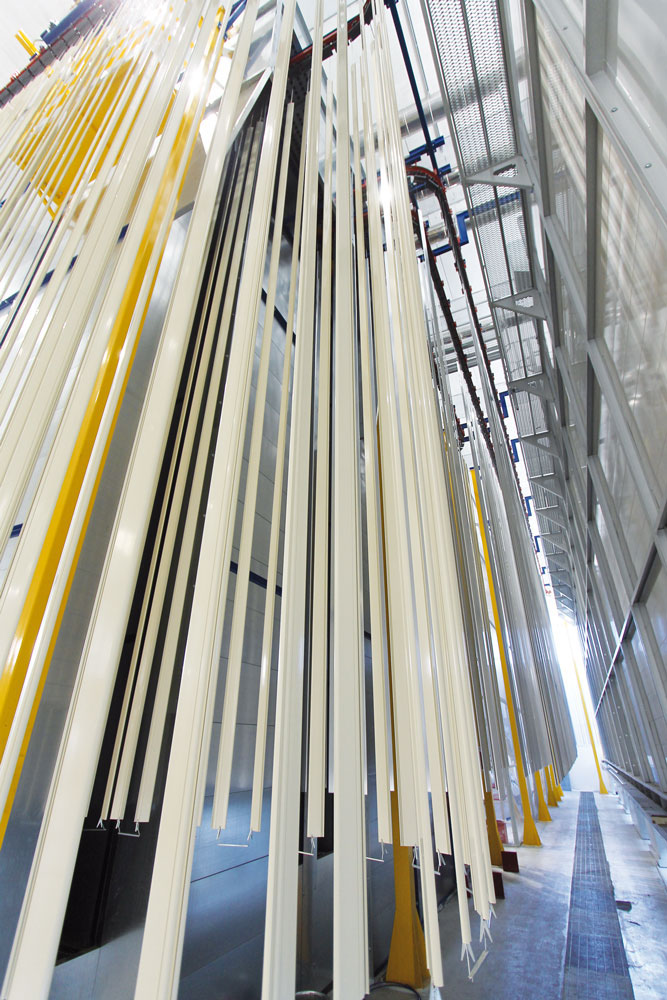 The Ruggeri Group specialises in the casting, extrusion, and coating of aluminium profiles, particularly for the door and window industry. © ipcm
The Ruggeri Group specialises in the casting, extrusion, and coating of aluminium profiles, particularly for the door and window industry. © ipcmSuffice it to say that we can currently produce billets on demand in 6060 alloy with a recovered material content of 87%, which places us in class A for recycled/recovered content according to the parameters of REMADE certification.”
Woodall: the first wood effect on aluminium
Probably due to the long-standing tradition of woodworking and coating in the Italian door and window industry, aluminium has been slow to be recognised in this country as a valid alternative to elements made of this natural material. Perhaps, however, this very reason was also at the root of the success of Woodall, the process Azeta patented in 1995.
Based on the idea to combine the strength and durability characteristics of metal with the warm and natural aesthetics of wood, it blends well with different architectural styles, especially in homes where wood is a central element. “Further advantages of coated aluminium elements compared to wood,” Ruggeri emphasises, “include lower maintenance requirements thanks to high corrosion resistance, better thermal insulation thanks to the techniques implemented (such as thermal cutting, which improves insulation and avoids heat dispersion), lightness to facilitate installation and reduce the overall load on architectural structures, and last but not least, environmental friendliness, as aluminium is 100% recyclable.”
The first vertical coating plant for profiles
Continuous production growth and new market requirements convinced the Ruggeri Group’s management to start an expansion project involving its foundry, whose surface area will be doubled, its coating department, integrated with the new vertical profile coating plant, and its packaging division. The work is scheduled for completion between January and February 2026.
Fabrizio Ruggeri, Salvatore’s son, who is joining his father at the company’s helm, points out: “The system designed and installed by Euroimpianti is the first installed in our factory for vertical profile coating. We have always worked with horizontal coating plants, but this vertical machine immediately proved to bring significant advantages over the others. Before choosing Euroimpianti as the supplier of this technology, we assessed other options, but its solution convinced us with its high automation performance, which would allow us to reassign our staff to other departments, and its increased capacity in terms of coated volumes, around 15 t/day, which would finally enable us to meet the needs of a market requiring increasingly higher quantities.
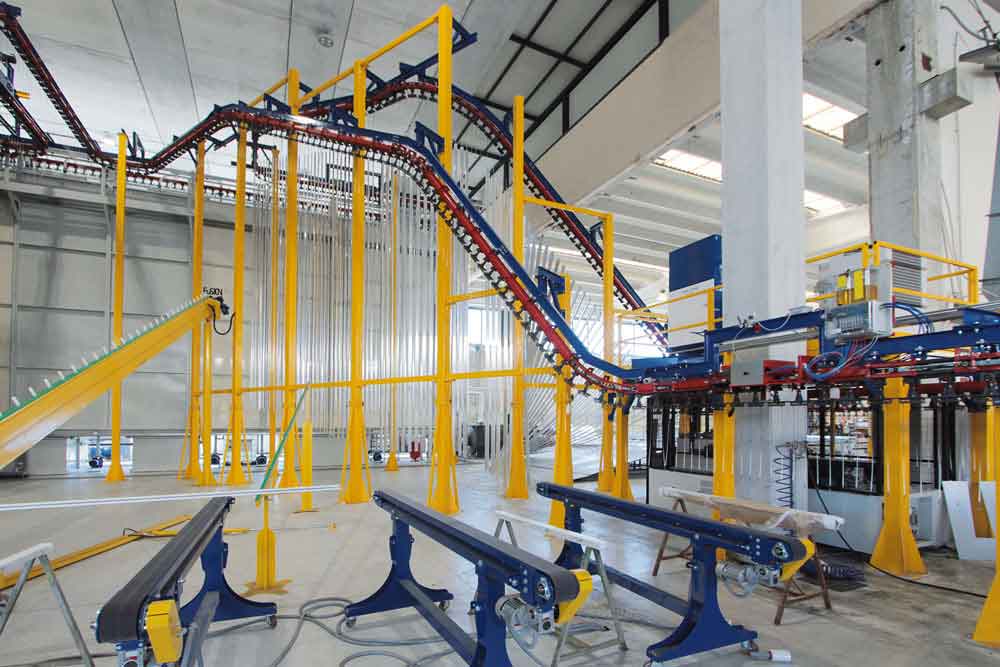 The monorail conveyor in the foreground and the drying and curing oven in the background. © ipcm
The monorail conveyor in the foreground and the drying and curing oven in the background. © ipcmA further benefit of vertical coating relates to the positioning of the heaviest profiles, which, by standing vertically, do not run the risk of bending, as can occur in horizontal plants, thus significantly reducing scrap rates.”
The main features of the coating plant
“Every plant designed by Euroimpianti,” indicates Gianluca Baruffaldi, CEO at Euroimpianti Group, “is configured and customised according to the number of aluminium profiles to be coated and the special requirements of each specific workflow. The system installed at Azeta boasts state-of-the-art technology, extreme reliability, and high production capacity, and it was the subject of an ad hoc study in terms of energy and thermal savings. It starts with a 10-stage pre-treatment tunnel. Every detail of the tunnel, such as segment length, tank characteristics, and interaxle spacing, is designed according to the requirements of Qualicoat and AAMA chemical treatment cycles. The last passivation stage is equipped with the Nebula system, ensuring that the workpieces are sprayed with a solution of consistent chemical quality while reducing water consumption. The machine has a chemical dosing, mixing, and control unit, an operating system with a touch-screen control panel, and spray bars with atomising nozzles. After pre-treatment, the monorail conveyor takes the components to the drying oven designed so that heat can be recovered from the parts as they cool.”
The diamond-shaped booths
The 2 coating booths belong to the Diamond series, whose name is inspired by their diamond-like shape. “What makes this application booth stand out is undoubtedly its geometry: thanks to the perfect symmetry of its structural components, profiles with any shape and cross-section can be coated with maximum performance,” states Antonio Cimenes, sales agent for the Veneto-based company. “It comprises a powder-coated metal structure that provides support and containment for a series of symmetrically opposed dielectric sheets. 4 reciprocators per side, specially angled gun bodies, and a linear conveyor path during coating ensure flexibility and control of application parameters. The side sheets delimiting the application area feature a software-controlled rotating movement that promotes powder recovery and facilitates and speeds up colour change operations. Cleaning inside the booth is fully automatic thanks to the dust extraction and recovery system consisting of a high-efficiency cyclone separator and a self-cleaning cartridge filter that intercepts dust particles not removed by the cyclone. The floor also consists of a rotating dielectric sheet that is automatically cleaned. The line is completed by a device that allows cleaning the hooks without chemicals.” Among Azeta’s main powder suppliers is Pulverit Spa, whose history began at the same time as the Apulian company.
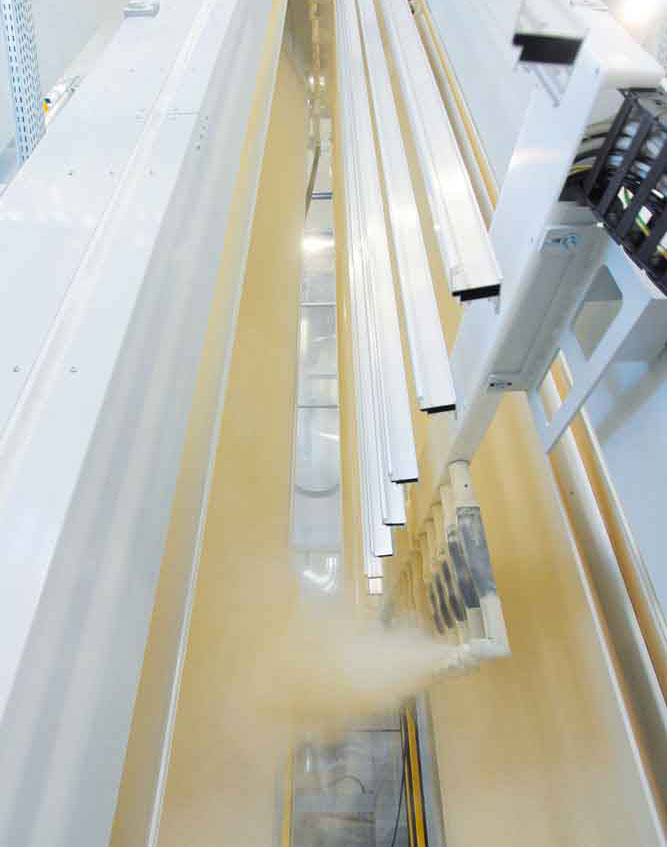 Each booth is equipped with 4 opposing reciprocators. © ipcm
Each booth is equipped with 4 opposing reciprocators. © ipcmThe vertical plant and the IPS powder management system: a winning combination
“This is the first vertical coating plant to adopt Wagner’s innovative IPS powder management system in the Italian aluminium industry,” emphasises Michele De Cesaris, Area Manager-Powder Coating at Wagner. “At the same time, we also supplied Azeta with our classic SuperCenter EVO powder centre, the first designed to be in line with Industry 4.0 parameters and already tried and tested with countless vertical coating systems: the SuperCenter EVO and the IPS plant work perfectly with each of the 2 booths.”
On the other hand, this combination has ensured considerable advantages: “The IPS powder centre increases productivity, guarantees high quality standards, streamlines operations, and reduces colour change times consistently.
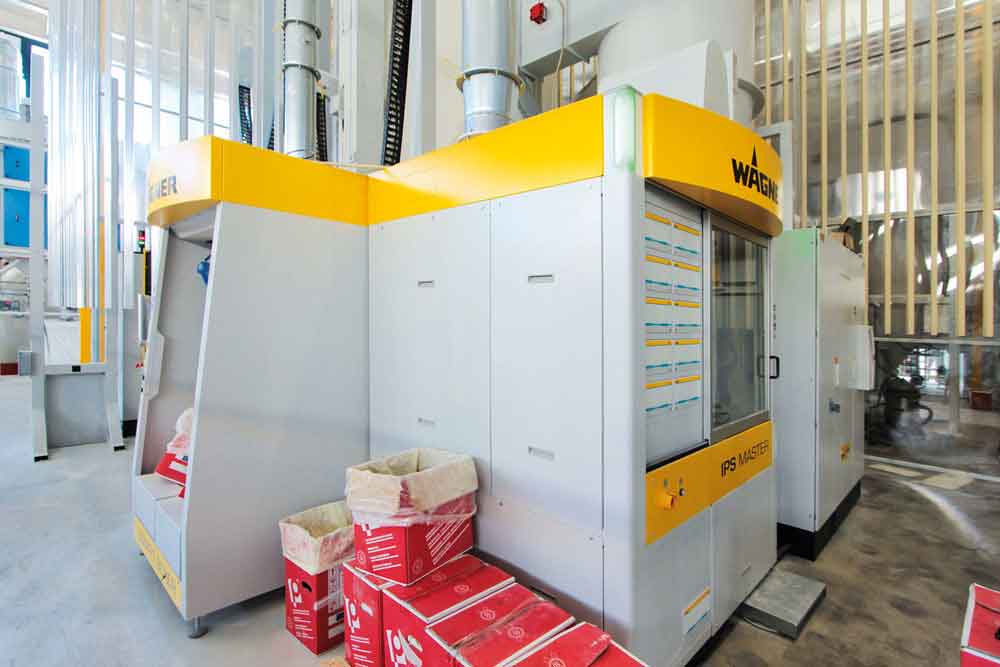 Wagner’s state-of-the-art IPS powder centre. © ipcm
Wagner’s state-of-the-art IPS powder centre. © ipcmThe powder feeding system is revolutionary, as it is based on the concept of working with a pressurised tank, without the use of pumps (Venturi or pinch), fully meeting the definition of high density. It is equipped with a twofold fresh powder feeding system, allows powder preparation by ultrasonic sieve, vibration, and fluidisation, and features special systems for accurate gun dosing. Its integrated sensors for weight, flow, pressure, and level and its fully automatic colour change system guarantee high productivity and cost efficiency, as the application remains consistent over time – over 2,000 hours without adjustments to the application parameters and therefore without routine maintenance.
Thanks to this new powder centre, Azeta can better manage paint consumption and spray fan patterns, thus improving coating performance, the most critical aspect for the Apulian company. “IPS also features the highest level of automation of colour change operations without human intervention, with centralised control of all process steps and real-time detection of powder consumption.”
The chemical-physical waste water treatment plant
The line is also equipped with a wastewater treatment plant for the pre-treatment tunnel, developed by Saita Srl of Limena (Padua). "The water treatment system we installed at Azeta," says Carlo Enrico Martini, Sales Manager of Saita, "is a traditional chemical-physical plant with a capacity of 2,000 litres per hour, where the diluted water discharged from the washing stages is treated continuously, while the concentrated wastewater is stored in a balancing tank and dosed into the same purification system. Demineralised water is produced and recovered in a closed loop within the washing tunnel tanks by a demineraliser with ion-exchange resins in a dual-line system with a capacity of 10,000 litres per hour."
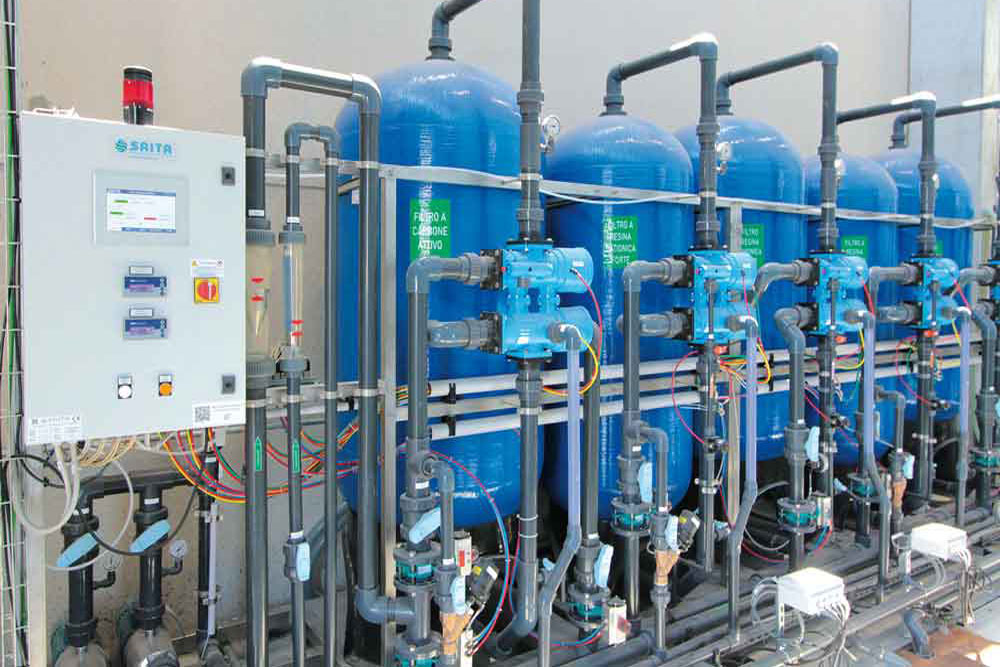 The demineraliser with ion exchange resins installed by Saita. © ipcm
The demineraliser with ion exchange resins installed by Saita. © ipcm
Conclusions
“Thanks to this new coating line, we will be able to consolidate our position as a supplier for the door and window frames industry and become an increasingly important player in the field of coated aluminium profiles, further increasing our production capacity and coating quality,” concludes Salvatore Ruggeri. “Even though the investment was significant, it is the result that matters. We are also satisfied with the partners we chose: Euroimpianti and Wagner’s teams demonstrated not only excellent skills but also a remarkable ability to adapt to our needs and even go the extra mile, as in the case of the second powder centre that Wagner provided us with to avoid issues with a system that had never before been tested with vertical coating technology. As a result, we have tripled our production capacity, reduced the number of shifts, and relocated our employees to other departments with different tasks.” That is going to confirm Azeta’s strategic role in the aluminium coatings sector: “The wood effect now has a large market, and we are currently developing a coating with the same effect on PVC. We are constantly looking for solutions to meet the demand for profiles with the most unusual effects: our history started there, and we will continue to pursue this path. We believe that Azeta’s future lies in this pioneering approach.”